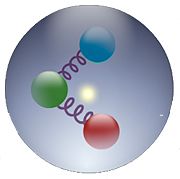- Number 319 |
- August 30, 2010
New measurement explores fine details of proton structure
During the experiment, the
probing electron seems to
give all of its momentum
to one quark, which then
passes part of it on to the
proton's other quarks. (Click
image for animation)
A new, high-precision measurement of the proton's hidden inner structure carried out at DOE's Jefferson Lab has yielded a surprising result.
A collaboration of scientists measured the proton's form factors, quantities that describe the shape and size of the space over which the electric charge and electric current is spread.
The proton gets its charge from its building blocks: three quarks. The electric charge form factor, GEp, is connected to the electric field generated by the quarks' electric charges. As the charged quarks move around, they generate an electric current, which creates a magnetic field. The magnetic form factor, GMp, is therefore related to the quarks' movement.
The experiment set out to measure the ratio of the two form factors:
GEp/GMp. Previous measurements by the collaboration found that the electric charge form factor decreases significantly faster than the magnetic form factor. The new experiment measured the smallest value of the ratio by 50 percent.
In the experiment, the proton was probed with high-energy electrons from Jefferson Lab's CEBAF accelerator. The angle at which the electrons leave the proton was then measured, determining the so- called momentum transfer.
The experimenters found that the decrease revealed in previous measurements shows indications of slowing down. This slowing could indicate that the momentum transfer is approaching the region in which the electron probe is no longer probing the proton as a whole, but is beginning to study the individual quarks.
In addition, the researchers suspect they are also seeing a special circumstance of how the electron probe is interacting with the proton and its quarks. The electron carries enough energy to shatter the proton, but intact protons are detected. The electron seems to give its momentum to one quark, which then passes part of it on to the proton's other quarks.
The result was recently published in the journal Physical Review Letters.[Kandice Carter, 757.269.7263,
kcarter@jlab.org]

